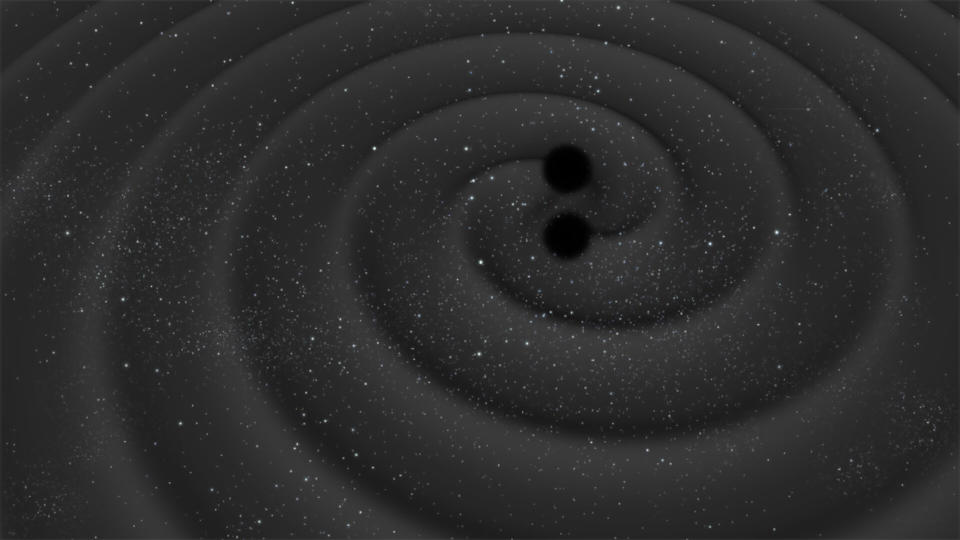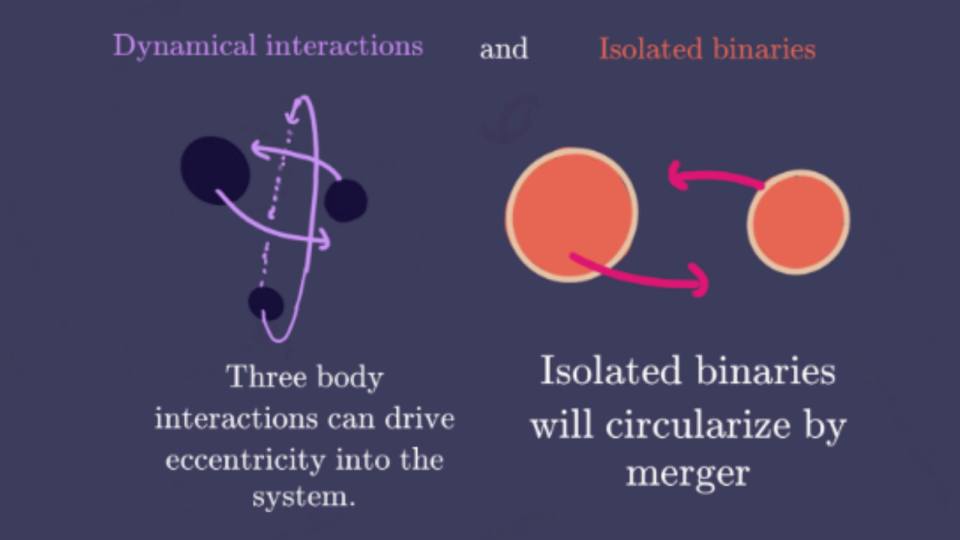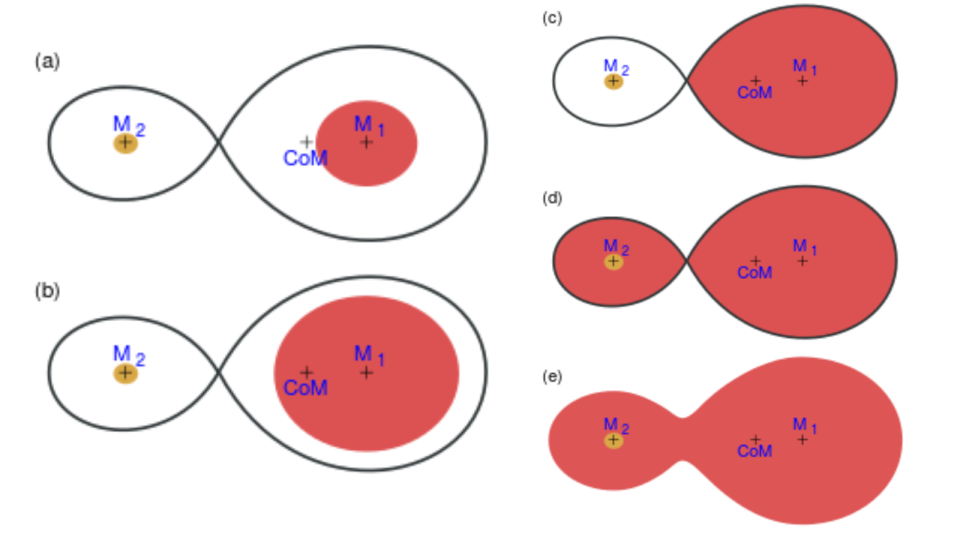Cracking! Some binary black holes may roll around each other in egg-shaped orbits

Black hole week reaches its conclusion today (May 10), and there's no better way to mark the occasion than with some "eggs-traordinary" black hole science.
Using gravitational wave measurements by the Laser Interferometer Gravitational-Wave Observatory (LIGO), based in the U.S., and the Virgo and KAGRA detectors, located in Italy and Japan, respectively, scientists have found that the orbits of some binary black holes could be egg-shaped and exhibit a curious wobble.
This research is more than a mere curiosity (and an "eggs-cuse" to crack some bad egg-related puns). The discovery of these oval-shaped orbits in binary black hole systems could help researchers determine how each of these systems was formed.
Related: Fall into a black hole in mind-bending NASA animation (video)
"We find that the majority of binary black holes are expected to be in what’s called 'quasi-circular' orbits. The 'quasi' just means that the separation of the black holes is decreasing over time due to the emission of gravitational waves," study lead author Nihar Gupte, of the Max Planck Institute for Gravitational Physics in Germany and the University of Maryland, told Space.com.
"Our study shows that a few of the binary black holes observed could be in 'eccentric' orbits," Gupte added. "This means that the black holes orbit in an oval or 'egg' shape."
The team also discovered that the tip of that egg-shaped oval orbit could rotate as the black holes orbit each other, the researcher said.
"We also found that if you analyze these events using a non-eccentric model, you will
overestimate the masses of the black holes," Gupte added.
What can we learn from egg-shaped black hole orbits
Gupte and his colleagues examined 57 binary black hole pairs detected via gravitational waves by the LIGO-Virgo-KAGRA collaboration. Gravitational waves are ripples in space-time that were first predicted by Albert Einstein in his famous 1915 theory of general relativity.
General relativity suggests that objects with mass create a curvature in the very fabric of space and time, united as a four-dimensional entity called "space-time." Gravity arises from this curvature, which gets more extreme as the masses of the objects increase. That's why stars have more gravitational influence than planets, and galaxies have more gravitational influence than stars.
Einstein also predicted in this revolutionary theory of gravity that, when objects accelerate, they send tiny ripples radiating out through space-time — gravitational waves. These ripples are insignificant, however, until the domain of ultradense objects like neutron stars and black holes is reached.
When binary neutron stars or black holes swirl around each other, they constantly emit gravitational waves, which carry energy away from the system in the form of angular momentum. The loss of angular momentum causes the orbits of these bodies to tighten, drawing them together until their gravitational influence takes over. Eventually, they collide and merge, sending out a final high-pitched screech of gravitational waves.
Einstein thought that even these gravitational waves would be too faint to be detected on Earth. Fortunately, in September 2015, LIGO proved the great scientist wrong, detecting GW150914, a gravitational wave signal from a black hole binary merger over 1 billion light-years away.
Related: The Laser Interferometer Gravitational-Wave Observatory (LIGO): Detecting ripples in space-time

As detections of gravitational waves have continued to ripple in, scientists like Gupta are learning how to use them to reveal details about the objects that create them, as this new research demonstrates.
Gupta explained that using gravitational waves to understand the orbits of binary black holes is akin to paleontologists studying bones to reconstruct how dinosaurs may have lived. Thus, physicists can study the properties of merging binary black holes to understand how binary black holes come together in the first place.
This can happen in two distinct ways. Dynamical interactions occur when a black hole binary encounters and interacts with another black hole, or even another black hole binary system.
On the other hand, binaries could be isolated and form more simply from two stars already circling each other that become black holes, or from one black hole wandering too close to another and forming a binary before they collide and merge.

"The key idea is that if we observe a binary with eccentricity, it probably comes from a dynamical interaction," Gupta said. "These chaotic interactions can break apart the binary and shoot their constituent black holes out of their host galaxies and galaxy clusters. But sometimes, they can also shrink the distance between the two black holes, induce eccentricity and cause them to merge on short timescales."
In addition to using orbital eccentricity to tell the story of black hole binaries, the scientist and his team are also interested in considering what the oval nature of orbits does to the gravitational wave emissions of these systems.
"When you have eccentricity, this means at some points in the orbit, the black holes are closer to each other," Gupta explained. "When black holes are closer to each other, they have a larger acceleration, which means they emit more gravitational waves. On the other hand, if they are far away, they have smaller acceleration, which means they emit fewer gravitational waves.
"So you end up seeing little blips in the amplitude of the waveform [the total pattern of gravitational waves], which occur from the black holes moving closer and further away from each other!"

The nature and history of binary black holes would be incredibly difficult to determine without the use of gravitational waves. An alternative method to understanding the origin of binary black holes is to look for so-called "common envelope" events with standard light-based astronomy.
These events kick off with a star and a black hole orbiting each other, with that star growing into a red giant. The outer layers of the swollen puffed star create a common envelope around both occupants of the binary, generating friction between the black hole and the star. This shrinks the orbit of the binary, and eventually, after the red giant has become a black hole, this leads to a binary black hole merger.
"The problem is that observing this critical period is hard with electromagnetic observations. This is because massive stars are rare and short-lived, so the critical evolutionary phases of compact object mergers occupy a small fraction of these systems," Gupta said. "By studying gravitational waves, on the other hand, we can understand the final moments of the binary merger. This can allow us to trace back the history of the merger and hypothesize what could've formed it."
He added that gravitational waves are especially useful in this respect because they are an "extremely clean probe" or distant events. This refers to the fact these ripples through space-time can travel vast distances without interference from whatever is between the binary and Earth.
RELATED STORIES:
— How do some black holes get so big? The James Webb Space Telescope may have an answer
— Brightest quasar ever seen is powered by black hole that eats a 'sun a day'
"While we don't claim these to be definitive detections of eccentric binary black holes, these results point towards eccentricity [in the] existing population," Gupte said. "This is an important consideration for the current Earth-based gravitational wave detector observing run, as well as future ground and space-based gravitational wave detectors.
"At present, we don’t have enough data to determine the origins of binary black holes conclusively. However, if we observe more eccentric binary black holes in the future, we can start to put constraints on which mechanisms form these systems."
The team's paper has not yet been published in a peer-reviewed journal. You can read a preprint of it at the online repository arXiv.

